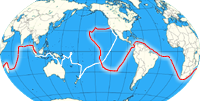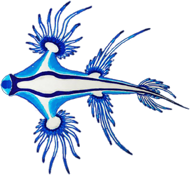After 26 days on the way from Hawaii to California we made landfall at the westernmost Channel Island – San Miguel. The island usually receives the brunt of the north-westerly winds, fog and severe weather from the open ocean. As we arrived around midnight the sky was clear, no fog and just a little wind blowing. So we decided to stop there for a few days. After safely dropping the anchor on a sandy patch we were woken up in the morning by loud, strange noises. It sounded like somebody was cutting some wood on deck, but it turned out it is the noise the northern elephant seals (Mirounga angustirostris) make. They were hunted almost to extinction in the 19th century but numbers have been recovering since. There are even some beaches on the mainland where the elephant seals are now common again.
San Miguel belongs to the Channel Islands National Park. The waters extending 6 miles from each island are a National Marine Sanctuary and protect threatened and endangered species within and on the Channel Islands. You can hike on San Miguel only with a ranger or nature guide, since it was used for military practice and has a very fragile ecosystem. Since the weather was warm, sunny and almost without wind we decided to hike to Cardwell point on the eastern side of the island and made an appointment with the guides on duty. There is a little sandy beach which is full of sea lions and elephant seals. You can sit on the ledge 10 meters above the beach and observe the animals without disturbing them or getting too close. There were at least 20 huge sub-adult and adult male elephant seals with their typical large proboscis, which looks like an elephant trunk, together with a few young ones lying on the beach and enjoying a lacy day. They males grow up to 5 meters and weigh up to 2.500 kg, so that they can hardly move. A lot of California sea lions (Zalophus californianus) use them to lie on top of them for warmth and comfort. Sea lions in comparison look really small and move much quicker and more graceful.
Elephant seals spend most of their life - more than 80 % - out on the open ocean to search for their food like squid, rays, skates, octopuses, eels and fish. They can hold their breath up to 100 minutes and dive down to 1.500 m depth. They only go ashore a few weeks each year. Mainly to mate, to mold, which means shed their old fur and get a new one, or the females to give birth and nurse their young. Males generally spent 3 months ashore, females about 5 weeks, during which they do not eat at all. GPS tracks have revealed that they swim as far as 3.000 miles to the northwest of the rookeries to find food.
We spent a few hours just watching them and the sea lions and enjoyed the view immensely. After the hike we went back to the boat and watched the elephant seals on the beach in front of us. There were a few males as well as some young ones waiting to mold. While beach combing we found a lot of parts of their fur lying in the sand.
San Miguel is really an amazing island and we would have liked to spend even more time there. But the weather started to turn and so we decided to sail for the mainland.







_and_California_Sealions.jpg)

_grow_up_to_5_m_and_a_weight_of_2500_kg.jpg)















.jpg)
.jpg)
.jpg)




 >>planned route - join us ...
>>planned route - join us ...